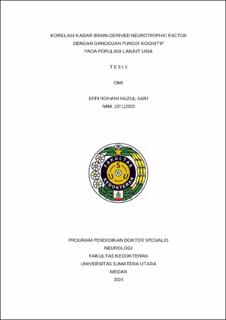Korelasi Kadar Brain-Derived Neurotrophic Factor dengan Gangguan Fungsi Kognitif pada Populasi Lanjut Usia
Correlation of Brain-Derived Neurotrophic Factor Levels with Cognitive Function Disorders in The Elderly Population

Date
2024Author
Sari, Effi Rohani Nuzul
Advisor(s)
Rambe, Aldy Safruddin
Fitri, Fasihah Irfani
Metadata
Show full item recordAbstract
Background:
Aging is a multifactorial process determined by genetic and epigenetic factors, causing a decline in cognitive function. Cognitive function is generally associated with neural plasticity. Brain-Derived Neurotrophic Factor (BDNF) supports neuronal survival, growth and differentiation of new neurons, increases synapse formation, plays a role in neurogenesis, and produces neural stem cells.
Objective:
This study aims to determine the relationship between BDNF levels and impaired cognitive function in the elderly population.
Methods:
This study is a correlative analytical with a cross-sectional design using primary data sources. Subjects who met the inclusion and exclusion criteria underwent a MoCA Ina examination which was then followed by taking blood samples to check BDNF levels.
Results:
Based on gender, there were 50 elderly women (56.8%) and 38 elderly men (43.2%) from a total of 88 research subjects. The median age of all research subjects was 69.5 years (61 – 92). There were 71 subjects (80.7%) with impaired cognitive function with a median value of 15.0 (2-28). Based on the cognitive domain, the most disturbance was in the abstraction domain (98.9%). Of the 88 subjects, the mean BDNF level was 1.55 (±0.62) with 50 subjects having normal BDNF levels (56.8%). A weak positive correlation was found between BDNF levels and the visuospatial-executive domain (r=0.232, p=0.029) and abstraction domain (r=0.249, p=0.019). And there was a significant difference in BDNF levels between the normal cognitive function group and the impaired cognitive function group in the MoCA-Ina score results (p = 0.029).
Conclusion:
There is a weak association between BDNF levels and cognitive function, especially in the visuospatial-executive domain and abstraction domain.
Collections
- Master Theses [156]
